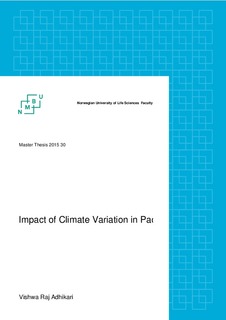Impact of climate variation in paddy production of Nepal
Master thesis

Åpne
Permanent lenke
http://hdl.handle.net/11250/294138Utgivelsesdato
2015-08-03Metadata
Vis full innførselSamlinger
- Master's theses (HH) [1072]
Sammendrag
Climate change and its consequences on various sectors (human health, water availability, agriculture) are important global issues. Agriculture sector is regarded as one of the sensitive sectors under climate change scenarios and the agriculture sector has a vital role in the economy of most developing countries. On this ground this study attempts to find out possible impacts of climate variation in paddy production of Nepal.
Panel data model based on Ricardian approach of climate variation was adopted for the study. I used two different datasets for two different geographical regions of Nepal, Hill and Terai with panel of five development regions. Paddy yield was taken as the dependent variable with maximum temperature, minimum temperature and precipitation as climatic variables and labor, bullock, improved seed, manure and fertilizer as agriculture input explanatory variables. The time period from 1990 to 2013 was incorporated to find out climate variation impacts on paddy yield.
The variation in maximum temperature over the study period has negative impact in paddy yield of both regions and the precipitation experienced during the study period has negative impact in paddy yield of the Terai Region.
The calculation from the test results showed that one-degree increase of maximum temperature will cause 127 kg per hector and 94.99 kg per hector decrease in paddy yield in Hilly and Terai Region respectively. One-millimeter increase in rainfall in Terai Region will cause 1.59 Kg per hector decrease in paddy yield.
My results indicate that future climate change in Nepal, including higher temperature and more rainfall, might have negative impacts in the agriculture sector.